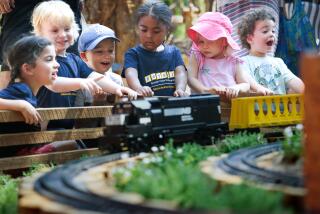Getting on Board the Railroad Hobby
- Share via
Question: I have hundreds of old railroad items, but I’m just getting around to attempting to put them in some sort of categorical order. Can you suggest a good starting point for what seems like an impossible task?--P.H.
Answer: Most collectors of what’s known as “railroadiana” attempt to place their valuables into two broad categories--paper and hardware collectibles.
Among the most popular paper collectibles are railroad timetables, some consisting simply of a sheet of paper, others elaborately printed with lithographed turn-of-the-century illustrations.
Other paper valuables might include railroad posters, signs, calendars, stock certificates and, of great interest, tickets.
On the hardware side, collectors search for old railroad keys, locks, lanterns, headlights and--if you have the bucks and space--even whole cars and locomotives to restore. Of particular interest to many collectors are railroad dining car items. Included would be china, ashtrays, napkins, towels and the like.
Much sought after are the classic hand-held official railroad watches that conductors and other employees used to record the movements of freight and passenger lines that have now passed into history. Other collectors say they’ve amassed such items as railroad uniform buttons with the names of the lines emblazoned on them, and even old railroad nails used until World War II to secure rail ties. On the heads of many of these nails are the last two digits of the years in which they were used.
Q: I collect wildlife prints and, of course, have a particular interest in the works of John Audubon. But I also have what I perceive to be valuable prints going back a century or more by artists who are not household names. Aren’t they also collectible?--F.M.
A: Indeed, they are highly collectible. To be sure, they don’t have the value of Audubon’s monumental “Birds of America” series, but they are nevertheless popular among collectors.
Although you didn’t describe in detail what you have, I suspect you may be referring to wildlife drawings executed by artists who accompanied government exploration expeditions of the 18th and 19th centuries. Thousands of these drawings were produced, and among the most popular are those drawn by artists who accompanied railroad surveyors into this country’s Wild West in the mid-19th Century.
When these artists returned to their East Coast homes, their drawings were reproduced on black-and-white plates or colored by hand. This is a good example of an area where collectors can still find relative bargains.
Q: I have more than a hundred strands of beads that have been in our family for a couple of generations. Some of them appear to go back a couple of centuries. How far back can we trace bead production?--M.B.
A: Beads that are a few hundred years old are still “babies.” Archeologists have discovered bead production in Egyptian civilizations dating back more than 6,000 years.
There are literally thousands of bead collectors in this country and abroad; beads are popular because collecting them can be as expensive or inexpensive as the collector wants to make it.
We couldn’t leave this subject without a comment on the work of the American Indians, who, unquestionably, have been experts in the art of beadwork for centuries. Collectors are attracted by their outstanding craftsmanship and because Indians usually used native materials, such as stones and shells.
More to Read
Sign up for The Wild
We’ll help you find the best places to hike, bike and run, as well as the perfect silent spots for meditation and yoga.
You may occasionally receive promotional content from the Los Angeles Times.






